
"Transgender spirituality has a much stronger heritage than most people realise."
|
| Click here to download an example ceremony. |
|
| Click here to download my brochure. |

"There are many examples of saints, sages and other revered people who expressed their transgender natures."

"Gender difference
is sacred. Let's
celebrate this precious
and beautiful gift."

One Spirit Interfaith Foundation
One Spirit Interfaith Foundation trains people to be Interfaith Ministers and offers cemonies, including wedding ceremonies and spiritual counselling to people of all faiths or none.
Transgender spirituality
This page offers a few thoughts on what different faith traditions have to say about gender. These notes are by no means comprehensive, but I hope that they might give you some assurance, if not food for thought, if you’re worried that being transgender is in some way incompatible with being spiritual. I am certain that this couldn’t be further from the truth.
I should say that on this page, as well as on other pages on this website, my use of the term "transgender" is mainly used as an anchor, or means of indicating that my ministry is about working with people who don't fully identify with the gender of their birth, as well as those of us who consider ourselves to be close to the middle or at least not at an extreme of the gender spectrum. As far as I believe, a FTM person who's now "come home" to their true gender, whether through transition or lifestyle, is a man (and similarly, a MTM person is female). However, if a person prefers to describe themselves as a "transman", simply as a human being, or in any other way, that's who they are. Similarly, if you consider yourself to be pangender, gender-fluid, genderless or third gender, how you describe yourself is what matters, not what labels anyone else might want to ascribe to you.
In spite of what might often be believed, trans people have a very honoured place in many faith traditions. Gender is seen to be sacred, and diversity is at the heart of what makes creation beautiful. Further, the patriarchy and guilt-focus that might feature in the memories of many of us who were brought up with Judeo-Christian beliefs don't necessarily fully align with the core teachings of these faith traditions either.
Many Eastern, African, Latin American, Slav and Native American traditions often elevate transgender people to being especially valued among humankind. Those of us who find our own connection with the Divine through a wide range of means, under what might broadly be termed 'modern spirituality', generally recognise that gender fluidity is very much a part of the wonderful mix in humanity. For example, those who believe that souls reincarnate many times and make choices about where, when, and to whom they are born, would see that there's always a reason that we choose to be born into the bodies and to prefer the genders that we have in each life, even if these appear to be at odds with each other.
Many deities worshipped by non-Western peoples are considered to be transgender or transcending gender. These include Ishi Kori Dome (Shinto); Daksha, Khandoba, and Tvastr (Hindu); and the Shooting God of the Navaho Native Americans.
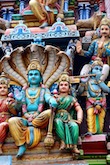 The great Hindu deity Krishna and his consort Radha are frequently depicted as taking on the gender identity of the other, or as merging and becoming one (an experience that is also the aim of Tantric practice).
The great Hindu deity Krishna and his consort Radha are frequently depicted as taking on the gender identity of the other, or as merging and becoming one (an experience that is also the aim of Tantric practice).
Shamans of all kinds often transcend gender when mediating with the gods. Indeed, the ability to "walk between worlds" is fundamental to Shamanic practise – shapeshifting and gender transcendence are fully a part of the Shaman's work. Rituals that incorporate transgender elements (for example, the Hindu Gopi, Hijras, Anatolian Gallae, and Inuit Qailertetang); and priests and priestesses who cross the so-called gender divide are numerous.
The German anthropologist Hermann Baumann recorded male-to-female transsexual priestesses and priests who practised in nearly fifty different countries. These include the Baptai (Greek), Devi (Hindu), Jogamma and Jogappa (Hindu), Kalaturru (Mesopotamia), Mahu (Hawaiian), Nestr (Hindu), and Telines (Greek).
 There are many examples too of saints, sages and other revered people who expressed their transgender natures. Roman Catholic saints who transcended traditional gender lines include Joan of Arc, Saint Anastasia the Patrician, Saint Barbara, Saint Euphrosyne, Saint Marina, and Saint Paula of Avila. Even one pope, Pope Joan, might be among their number, although her existence is disputed by some. In the Hindu tradition, the deeply revered Bengalese saint Sri Ramakrishna Paramahansa, whom Mahatma Gandhi described as "a living embodiment of godliness", spent time dressing and living as a woman.
There are many examples too of saints, sages and other revered people who expressed their transgender natures. Roman Catholic saints who transcended traditional gender lines include Joan of Arc, Saint Anastasia the Patrician, Saint Barbara, Saint Euphrosyne, Saint Marina, and Saint Paula of Avila. Even one pope, Pope Joan, might be among their number, although her existence is disputed by some. In the Hindu tradition, the deeply revered Bengalese saint Sri Ramakrishna Paramahansa, whom Mahatma Gandhi described as "a living embodiment of godliness", spent time dressing and living as a woman.
Two Spirit (Alké ‘na ‘a cï) people are revered among Native American traditions, whose transgender deities include Ahsonnutli, Awonawilona, and Begochidi. "Third gender" and intersex people are recognised in many other cultures, including the Kathoey of Thailand, the Bayawan of he Philippines, and the Muxe of Mexico.
From the mythology and traditions of earlier times, shape shifters and deities who blended genders include Athena (Greek), Dionysus (Greek), Loki (Norse), Mut (Egyptian), and Sithon (Greek), to name just a few.
In many traditions, “God”, or “the Divine”, is not seen to have any gender at all, or if (S)He is accorded a gender, it is one that combines both feminine and masculine attributes. Indeed, the God of Christianity may have come to be seen solely as the “Father” as a result of a language translation, than who Jesus and others would have spoken about. Rather, the original meaning of the Aramaic (the language of Jesus), Abwoon, is given by the Sufi and language scholar Neil Douglas-Klotz to mean something akin to “The One from whom breath enters being,” or, “Father-Mother who births unity” [1].
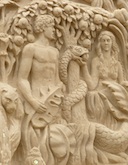 The Creation stories of many traditions also speak of a genderless or androgynous creator: for example, the Hindu, primordial being Purusha is considered to have divided into male and female in order to create humanity; there are echoes of this idea too in the creation stories of some Judaic writings, in which Adam, or rather Adam Kadmon, is thought to have combined both masculine and feminine attributes; German mythology similarly refers to the multi-gender nature of the first human, Tuisto. These themes are repeated in the teachings of many if not most different traditions.
The Creation stories of many traditions also speak of a genderless or androgynous creator: for example, the Hindu, primordial being Purusha is considered to have divided into male and female in order to create humanity; there are echoes of this idea too in the creation stories of some Judaic writings, in which Adam, or rather Adam Kadmon, is thought to have combined both masculine and feminine attributes; German mythology similarly refers to the multi-gender nature of the first human, Tuisto. These themes are repeated in the teachings of many if not most different traditions.
What the major faiths have to say
So what about the teachings of the major faiths of today – what do they have to say about those who change, or wish to change, their birth gender? Of course, there isn’t universal agreement on all points of faith, however the following viewpoints might be worth consideration. It's worth bearing in mind that the way gender is defined in Western societies might be thought of as being a social construct, one that might not be readily understood by many faith practitioners of old.
It’s also worth noting that some major faith organisations are beginning to offer namings and other ceremonies to mark transition. For example, a motion has recently been made by a vicar who has conducted namings, asking the Church of England's General Synod to consider ceremonies to recognise this [2], while TransTorah provides ceremony support for Jewish transpeople.
Buddhism
Buddhism teaches the way to escape continuing suffering, to be freed from the cycle of reincarnating in human form. When the ego self has finally been quietened and all worldly delusions faded away, nirvana, or ultimate bliss, is achieved. This is a state in which masculine and feminine are fully merged; one in which gender ceases to lose meaning.
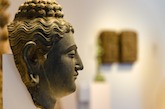 Buddhists hold that bodhisattvas are individuals who are ready to be freed from the cycle of birth and death, but who've chosen to be in the world to teach the way to enlightenment to others. Well known bodhisattvas include several transgender beings among their number, including Avalokiteshvara, Kannon, Kuan Yin and Tara (men who meditate on the Buddhist and Hindu goddess Tara are said to undergo a gender metamorphosis as her spirit enters their bodies). Guru Rinpoche, the Tibetan Buddha and “Precious Master” is said to manifest in different forms, and to be one who consumes all dualistic thoughts.
Buddhists hold that bodhisattvas are individuals who are ready to be freed from the cycle of birth and death, but who've chosen to be in the world to teach the way to enlightenment to others. Well known bodhisattvas include several transgender beings among their number, including Avalokiteshvara, Kannon, Kuan Yin and Tara (men who meditate on the Buddhist and Hindu goddess Tara are said to undergo a gender metamorphosis as her spirit enters their bodies). Guru Rinpoche, the Tibetan Buddha and “Precious Master” is said to manifest in different forms, and to be one who consumes all dualistic thoughts.
Christianity
As with the other Abrahamic faiths, Islam and Judaism, reference is made by some Christians to the Old Testament instruction that “A woman must not wear men's clothing, nor a man wear women's clothing, for the LORD your God detests anyone who does this” (Deuteronomy 22:5, New International Version).
This condemnation of cross dressing in the Old Testament might be interpreted to mean that any expression of transgender feeling is incompatible with the faith.
 However, some historians believe that some of the laws of the Pentateuch (the first five books of the Hebrew Bible) were meant to guard against practices observed by the many rival gods to Jaweh, notably those worshipped by the Canaanites – Asherah, the Mother Goddess, and her male consort, Baal [3]. Others point to the rise of patriarchy, another reaction to what were formerly matriarchal and Goddess-worshipping societies. Historians suggest that intolerance toward perceived gender variance subsided as tensions between the Israelites and Canaanites reduced.
However, some historians believe that some of the laws of the Pentateuch (the first five books of the Hebrew Bible) were meant to guard against practices observed by the many rival gods to Jaweh, notably those worshipped by the Canaanites – Asherah, the Mother Goddess, and her male consort, Baal [3]. Others point to the rise of patriarchy, another reaction to what were formerly matriarchal and Goddess-worshipping societies. Historians suggest that intolerance toward perceived gender variance subsided as tensions between the Israelites and Canaanites reduced.
It’s possible too to see that this law might have been thought necessary to guide a nomadic desert people that was prone to ill-discipline, not being unlike the sort of disciplines applied to condition a sense of order in the military. At any rate, the scripture doesn’t seem to make a comment on transgender nature per se.
The New Testament is less doctrinal than the Old Testament, although the Apostle Paul does give many instructions to the members of the early church. The importance of achieving unity with Christ, with God and in Spirit, is at the heart of the Christian message. The focus of Christian teaching is on being free from worldly attractions, on being reunited with Divine in the Body of Christ, a body which holds space for all who repent (literally meaning to “think differently”, or come back in touch with the true, inner and divine self).
Like the enlightenment spoken about by Buddhists, Hindus, Jains and others, this is a state of being that knows no boundaries, one that’s outside of time and notions of male and female. Even Saint Paul says, in his letter to the Galatians: “There is neither Jew nor Gentile, neither slave nor free, nor is there male and female, for you are all one in Christ Jesus” (Galatians 3:28, New International Version).
Jesus himself isn’t recorded as expressing a view on transgender people, though he was very forthright in challenging the hypocrisy of many religious zealots of his time, as well as being strongly expressive on many other matters relating to the “right” ways of thinking and living (which often parallel those of Buddhists and other faith traditions).
Outside of the scriptures and teachings of Western and Orthodox Churches, the long-suppressed Gnostic writings and Celtic traditions, with their emphasis on transcending the world of the “flesh” and reuniting with the Spirit of God, seem to offer considerable scope for accepting that our gender isn’t necessarily tied to the physical bodies that we take on at birth. My own view is that a creative God should love variety; that while there's a place for binary or contrasting natures in a partnership, there's every scope too for those who don't fit with this pattern.
Hinduism
Hinduism teaches that moksha is the achievement of nirvana (see note above), or union with the divine ground of being, Brahman. Jains hold this same belief, a state that is beyond gender.
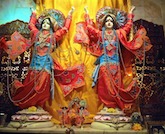 There are many transgender deities in the Hindu pantheon. Ardhanarishvara, a being created through the union of Shiva (masculine) and Shakti (feminine), is venerated as a Lord who is beyond the gender binary. Arjuna, the son of the great god Indra and beloved companion of the Lord Krishna, took on a feminine role in the court of King Virata. Krishna and Radha, as already mentioned, often transcended their genders.
There are many transgender deities in the Hindu pantheon. Ardhanarishvara, a being created through the union of Shiva (masculine) and Shakti (feminine), is venerated as a Lord who is beyond the gender binary. Arjuna, the son of the great god Indra and beloved companion of the Lord Krishna, took on a feminine role in the court of King Virata. Krishna and Radha, as already mentioned, often transcended their genders.
Of Hindu devotees, Asanga is among those who was changed into a woman, and then back into a man. The Rig Veda, the sacred collection of hymns, also alludes to gender change in at least one verse (Rig Veda 8.33.19).
Islam
Followers of shari’a law in Islam are clear in the direction set out for them in Scripture, but Muslims who are led by the principle of tariqa, or "way of salvation", accord a high place to self exploration and mystical experience.
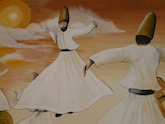 Sufis, Muslim mystics (although not accepted as being followers of the True Faith by fundamentalists), do not discriminate against being transgender, which they see offers no barrier to a person achieving (spiritual) oneness with God through meditations and devotion.
Sufis, Muslim mystics (although not accepted as being followers of the True Faith by fundamentalists), do not discriminate against being transgender, which they see offers no barrier to a person achieving (spiritual) oneness with God through meditations and devotion.
Judaism
Adherents of the ancient laws of the Old Testament might point to the often-quoted verse in Deuteronomy regarding crossdressing, mentioned above.
 However, Jewish mystics might usually take a different view. Kabbalists, who study the revealed teaching of wisdom known as Kabbalah, view androgony as an attempt to restore original pangendred nature of the original human being, Adam (or Adam Kadmon).
However, Jewish mystics might usually take a different view. Kabbalists, who study the revealed teaching of wisdom known as Kabbalah, view androgony as an attempt to restore original pangendred nature of the original human being, Adam (or Adam Kadmon).
The Fall spoken about in Genesis is equated by some as coinciding with the separation of a pangendered essence into male and female, or of a coming of “duality”. Souls that encompass both masculine and feminine, or ones that transcend or wish to cross the supposed divide, might then be thought to be particularly blessed.
Daoism
 Daoists believe that Yin (traditionally seen as feminine) and Yang (traditionally masculine) energies arise from the Tao, the divine energy pervading all life. The Tao reflects “wholeness, including gender wholeness…Taoists revere Nature as the earthly manifestation of the Tao and believe that individuals should seek to emulate its fluid patterns rather than constraining [ones]” [4]. To be integrated with this flow is to truly live; to change and to grow are the consequences that must follow.
Daoists believe that Yin (traditionally seen as feminine) and Yang (traditionally masculine) energies arise from the Tao, the divine energy pervading all life. The Tao reflects “wholeness, including gender wholeness…Taoists revere Nature as the earthly manifestation of the Tao and believe that individuals should seek to emulate its fluid patterns rather than constraining [ones]” [4]. To be integrated with this flow is to truly live; to change and to grow are the consequences that must follow.
Further information
If you’d like to explore this subject more, some excellent books that I can recommend are:
Hermaphrodeities, The Transgender Spirituality Workbook, by Raven Kaldera, Asphodel Press (2010),
Transgender Warriors, by Leslie Feinberg, Beacon Press (1997),
Transgender Spirituality, Man into Goddess, by Sakhi Bhava (2012), and
Cassell’s Encyclopedia of Queer Myth, Symbol and Spirit, by Randy P. Conner, David Hatfield Sparks and Mariya Sparks, Continuum International Publishing Group Ltd., Reissue edition (1997).
While not relating specifically to spirituality, the following offer some very thoughtful reflections on what it means to be 'trans':
Quantum Desire: A Sexological Analysis of Crossdreaming, by Felix Conrad, 2016,
Transgender: Fact or Fetish - Reality or Delusion?, by Felix Conrad, 2016,
A Creative Crossdreamer Vocabulary: Reflections on Transgender, by Jack Molay, 2015.
Excellent on-line resources include:
Crossdreamers, an excellent blog with links to numerous online resources, sites, articles and more.
Crossdream Life, a respectful online forum and library of resources for transgender people and their partners/others. Includes dedicated forums for female-to-male folks and also for families and significant others.
I hope to add further information and reflections on this page in due course.
Notes:
[1] Quote from The Hidden Gospel: Decoding the Spiritual Message of the Aramaic Jesus by Neil Douglas-Klotz, Quest Books, (2001), p 20.
[3] For example, see Vern L. Bullough and Bonnie Bullough, Cross Dressing, Sex and Gender, University of Pennsylvania Press (1993).
[4] Quote from Randy P. Conner, David Hatfield Sparks and Mariya Sparks, Continuum International Publishing Group Ltd., Reissue edition (1997), p 12.
|
Clive Johnson Email: clive@clivejohnsonministry.com Phone: +44 (0)7956 942980 Skype: cliverj2 |  Registered member. The Interfaith Ministers Association. |
